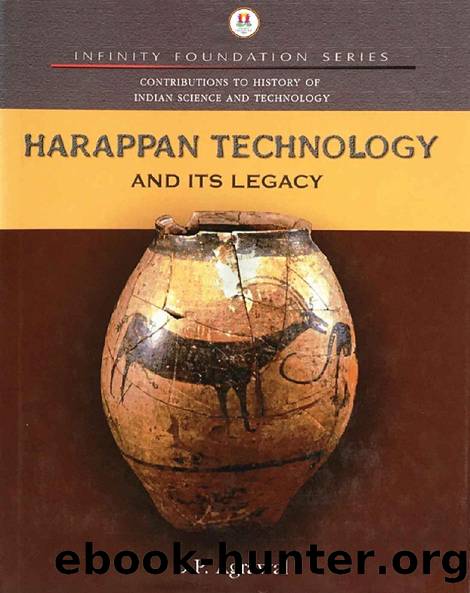Harappan Technology and its Legacy by D.P. Agrawal

Author:D.P. Agrawal [Agrawal, D.P.]
Language: eng
Format: epub
Publisher: Infinity Foundation India
Published: 2020-11-12T00:00:00+00:00
Silver
There is some controversy regarding the sources of silver. Chakrabarti (1990), while emphasising the significance of Afghanistan as a possible source of Indus copper, lead and silver, says that each of these metals is easy to procure in Baluchistan, Rajasthan and Gujarat. Ratnagar however thinks that there was no indigenous production of silver in India until a fairly late period, and that the Harappan silver came from Mesopotamia. Chakrabarti argues that this statement does not appreciate the extent to which India has argentiferous galena in the lead-zinc deposits of Zawar and Agucha in Rajasthan.
Ratnagar, replying to Chakrabartiâs criticism about silver, says that this point about two urbanised termini of the trade comes across vividly when the silver trade is considered. Little silver has been found in the intermediate areas of southeast Iran, Seistan, or the Gulf, except for two silver artefacts at Shahr-i-Sokhta in Seistan and two silver beads in an Oman grave. She had earlier argued (Ratnagar 1981: 144-46) that the Harappans, who were the only people of proto-historic South Asia to have used silver on a substantial scale, imported this metal, most likely from Mesopotamia. A regular movement of silver from the Assyrian merchant colonies of Cappadocia to Mesopotamia, is well documented for the period between 1920 and 1750 BCE, and texts from Ur which refer to silver being taken overseas by merchants to buy copper in Dilmun (clearly an entrepôt) date to the time of Rimsin of Larsa (1822-1763 BCE). It had also been pointed out that silver occurs in the three large Harappan settlements, Kunal, Mohenjodaro and Harappa, but is almost totally absent at other sites. Another argument in favour of Mesopotamia being the source is that even earlier, around 3500-3000 BCE and also later, silver and lead were used on a substantial scale in Mesopotamia and Elam. One example is provided by the Early Dynastic III Royal Cemetery at Ur, with a truly exceptional amount of silver (Moorey 1985: 114 ff, 122 ff). Secondly, there is now a run of radiocarbon dates from the silver-lead bearing localities of Dariba, Agucha, and Zawar, near Ajmer in Rajasthan, which testify to mining in the later part of the first millennium BCE, rather than earlier (Craddock et al. 1989). The only earlier mining is attested to at Dariba, but the dates are post-Harappan, namely, the later part of the second millennium BCE. Finally, it needs to be mentioned that Kosambi noticed traces of cuneiform writing, on a rectangular piece of silver from Mohenjodaro. He expressed his surprise that neither Marshall nor Mackay had paid attention to it; but, as copied by Kosambi, the cuneiform signs are not complete (Ratnagar 2008: 77-79).
The late Shashi Asthana (1993), who did some very important studies on Indus trade, has made some interesting observations about silver, in the Harappan context. Asthana thought that silver was apparently quite popular with the Harappans living at Mohenjodaro and Harappa, but those at Lothal and Kalibangan rarely used it. Silver was used for making vases and ornaments, such as bracelets, bangles and beads.
Download
This site does not store any files on its server. We only index and link to content provided by other sites. Please contact the content providers to delete copyright contents if any and email us, we'll remove relevant links or contents immediately.
| Africa | Americas |
| Arctic & Antarctica | Asia |
| Australia & Oceania | Europe |
| Middle East | Russia |
| United States | World |
| Ancient Civilizations | Military |
| Historical Study & Educational Resources |
The Third Pole by Mark Synnott(676)
Money for Nothing by Thomas Levenson(624)
Christian Ethics by Wilkens Steve;(570)
The Economist (20210109) by calibre(563)
Made in China by Anna Qu(540)
100 Posters That Changed The World by Salter Colin T.;(498)
Reopening Muslim Minds by Mustafa Akyol(484)
Routledge Handbook of Contemporary India by Knut A. Jacobsen(476)
The Irish Buddhist by Alicia Turner(469)
Nonstate Warfare by Stephen Biddle(460)
Culture by Terry Eagleton(457)
The Great Pyramid Void Enigma by Scott Creighton(448)
The Age of Louis XIV: The Story of Civilization by Will Durant(434)
Ideology by Eagleton Terry;(432)
The Shortest History of China by Linda Jaivin(431)
Objects of Vision by Saab A. Joan;(425)
Banaras: CITY OF LIGHT by Diana L. Eck(423)
The Jews of Silence: A Personal Report on Soviet Jewry by Elie Wiesel(420)
Sybille Bedford by Selina Hastings(411)
